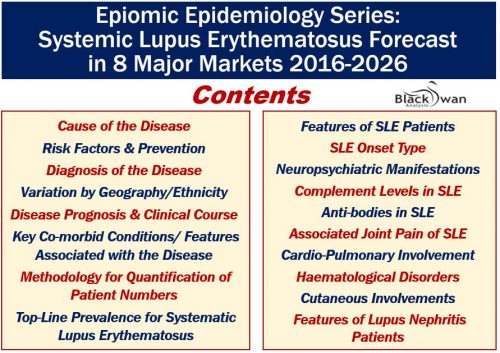A new comprehensive lupus study includes a disease overview, diagnosis, and prognosis over a ten-year period ending in 2026. Lupus, systemic lupus erythematosus, or SLE is a chronic, systemic, autoimmune disease.
Chronic means it is long-term, while systemic means it affects the whole body or many parts of it. Autoimmune means the body’s immune system is attacking itself, i.e., attacking good cells and tissues.
As it can affect many different parts of the body, signs and symptoms vary significantly. In fact, experts say that no two cases are ever the same. There are many possible treatments for patients with lupus. Doctors determine how to treat each patient according to their signs and symptoms. The global market for lupus treatments is huge.
This lupus study reports on disease prevalence and incidence in the world’s eight major economies. The eight economies are the USA, Japan, Germany, UK, Italy, France, Brazil, and Spain.
The authors, from Black Swan Analysis, grouped the lupus patients according to gender and age groups.

Lupus study – comprehensive
Apart from data on the current prevalence of the disease, the lupus study has an overview of it.
It also has information regarding disease diagnosis, risk factors, and prognosis. As the authors point out, risk of developing the disease varies according to geography and ethnicity.
This lupus report also quantifies the main co-morbidities and symptoms of SLE. The authors present this data alongside the overall prevalence figures.
According to Global Information Inc.:
“Providing a value-added level of insight from the analysis team at Black Swan, several of the main symptoms and co-morbidities of SLE have been quantified and presented alongside the overall prevalence figures.”
“These sub-populations within the main disease are also included at a country level across the 10-year forecast snapshot.”
Lupus study – symptoms and co-morbidities
A co-morbidity is another disease or disorder that is co-occurring with the primary disorder or disease. In this case, the term means ‘other diseases/disorders that may be present alongside lupus.’
According to the authors of the report, lupus patients may also have:
– Raynaud’s phenomenon: poor circulation in the fingers and toes.
– Infections. The Victoria State Government in Australia says: “The most common infections for people with lupus include those of the respiratory tract, skin, and urinary system.”
– Skin conditions: skin rashes, for example, are common among lupus patients, especially after exposure to sunlight.
– Osteoporosis: the National Institutes of Health in the USA says “Studies have found an increase in bone loss and fracture in individuals with SLE. Individuals with lupus are at increased risk for osteoporosis.”
– Arthritis: The Lupus Foundation of America says that among lupus patients, arthritis is a common consequence of inflammation. After a long period of uncontrolled lupus, patients may have problems even when there is no flare-up.
– Anemia: lupus patients may have a low red blood cell count. According to Lupus UK: “Low red cell counts and the associated low level of hemoglobin in the blood can result from the effect of antibodies attacking the red cells and causing their destruction, a process called hemolytic anemia.” (UK spelling: anaemia, haemoglobin, haemolytic)
– Lupus Nephritis: sometimes lupus causes inflammation of the kidney, we call that ‘lupus nephritis.’ ‘Nephros’ is Greek for ‘kidney.’ The suffix ‘itis’ comes from Greek and then Latin; it means ‘inflammation.’
– Serositis: inflammation of the serous tissues of the body, such as the tissues lining the heart. There may also be inflammation of the serous tissues lining the lungs and the inner lining of the abdomen.
Lupus study – data source
Regarding this lupus report, Global Information Inc. writes:
“This report is built using data and information sourced from the proprietary Epiomic patient segmentation database.”
“To generate accurate patient population estimates, the Epiomic database utilizes a combination of several world-class sources that deliver the most up to date information from patient registries, clinical trials and epidemiology studies.”
“All of the sources used to generate the data and analysis have been identified in the report.”

